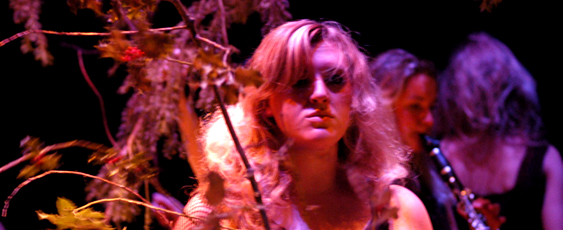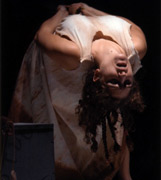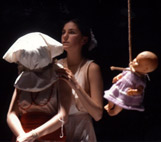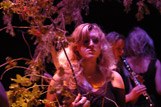
Through the Threshold
Having created and performed solo and ensemble devised works for almost twenty years, Carran Waterfield describes two rite-of-passage performance projects she created with young female theatre undergraduates.
I began making theatre professionally in the mid '80s when I had just turned thirty. That's late to get physical. What I had going for me was a good foundation as a schoolteacher which equipped me with an ability to communicate and all the organisation skills that come with school teaching; vast amounts of experience of amateur work and a knowledge that I wanted to be the creator of my own work. The network of educational contacts I had provided me with the arena I needed to trial the work and basically I learned on the job.
What I didn't have was any formal theatre training, which was advantageous because it made me a practitioner with my own ethos and way of working. It made me receptive to the influences of the masters but not a slave.
Almost twenty years later...
October 2004: I am in a studio laboratory within the department of Drama and Theatre Arts at Birmingham University with a group of fifteen young women. We are living those first ten minutes that will determine our relationship and the outcome of this project over the next four weeks. We are beginning to make Beastly Beauties. It's a devised piece for which I have been brought in as guest director. It is the second piece I have made in the academy this year.
My six solo works and fifteen ensemble works to date have always taken a year to make - that for me is the real world. The institution for obvious reasons cannot reflect the independent world of theatre making, so this one has to come in four weeks. Fortunately three of the fifteen women are collaborators from 7777 All Good Girlies Go to Heaven, the first piece made earlier in the year.
Twenty years ago this would not have been an opportunity for students within this academy. It is my understanding that traditional theatre undergraduate courses have been conventionally text driven. They have built a reputation based on the scripted play and the authority of the playwright. It is he - and it usually is a he - who owns the right to play out his imagination in the space only sometimes in collaboration with the director. This is the tradition in the UK. However, it is 2004 and much has been achieved in the name of physically driven work with a more Euro-Asian-centric flavour and so it is with some hope we are making this type of work. It is coincidental that in this particular instance this is 'women's work' - though much can be drawn as evidence that devised theatre made by women is strongly linked to the oral tradition of storytelling or 'gossip as you go along', not primarily about the written text.
Strangely, within the walls of what to me seems one of the more traditional academies, I find a willingness to take the work on, thanks to the Head of Department, Dr Maggie Gale; so I go the whole way with folk, fairies and feminine angst, hanged women and Sumerian mythology. In both pieces I was looking at the rite of passage that the young woman at university is passing through. This is fundamental to the truth of the work, and my engagement with the performers in a reality they understand. What can they illuminate for their peers, parents and 'youngers' when they get to the point of sharing the performance with an audience? And how on earth are actors born in a three-year academic degree? The answer is they are not... however, this opportunity has given me the chance to facilitate a kind of on the job training experience that should sow seeds that will in time reveal to the young practitioners what they need to do to set in motion an attitude towards training that goes hand in hand with making the work.
First observation: must see the women as equal co-creators
At no point in the creation of these two productions did I view the women as students. To me they were actors with whom I was working professionally, not serving any worthy cause. I didn't want to make a piece about any social issue. I am acutely aware of the social conscience-driven culture we currently inhabit in the UK where the identified audience or theme has to have some educational purpose. In this instance I was being purely selfish in continuing my artistic journey in whatever landscape I could make it happen, in refusing to deliver social work in the shape of art by design rather than by coincidence. So here in this academic context I adopted an approach that required these women to work in a professional manner as equal artists with me with all the expectations that go with that. But I insisted that they be themselves - I banned acting and outlawed the conventions of mainstream theatre as well as the virtuosity of physical theatre. We were going to make the work for the work's sake.
Please leave your theories in the cloakroom.
The Stage Management course that supported the production programme aspired to a professionally driven ethos in a similar way but with a focus on conventional theatre production methods, which made for lots of potential problems embodied in this collision of two very different mindsets. I have the hugest technical team any repertory theatre would envy - in my own work I am used to one technician and me doing everything on the road. Our creative team is always minimal. How far from my reality can you get?
Getting started
Today they are all here - actors and technicians - I invite the techies to do the physical work and put my assistant director on the camera because I know this session is key. They are nervous, so am I. We introduce ourselves. The space is charged with embarrassment and a fear of the unknown. I always love this moment - the beginning, the threshold. Essentially I am interested in how feminine archetypes reveal themselves in these particular performers' bodies, attitudes and dream worlds. I have asked them to research in response to the production blurb I had to write for the department's brochure. I know their dreams and challenges as they live out the journey will give far more food for the marketing brochure in its own time but ho-hum we have to live in the real world of selling...
This workshop is about orientation - the run, some of the principles of intuitive physical performance I have used consistently over the years. I want to make introductions the heart of the workshop so after an extensive workout I get them to speak to camera 'on the run' and 'tell' their research about their choice of tree and fairytale.
Interestingly, some of the more conventional performers say that they are the character from the fairytale. It is reminiscent of 'Tonight Matthew, I'm going to be...' They view having a part as being important and I deduce from this that they know little of the idea of being a channel for energies. Secretly I want to play with the old cliché about drama being all about 'pretending to be a tree'. Trickster-like, I take this literally and it informs the work. The choices of tree and fairy/folktale character reveal to me something about their inner worlds and their experience of theatre. The workout reveals their physical states.
The tree will become the shamanic wand that will unleash the chaos of the darker moments of the piece. Their tale the psychological terrain in which they will play and butt up against each other as they conjure up the archetype and work out the competition for the main part that doesn't exist!
I choose to work with the tree as an image because for me it conjures up associations of birth, magic, nationality and to some extent the struggle within nature. For me, you can read 'human' for 'tree' in this work. The distinct species of tree and the mythology of the tree can equate with the individual's particular personality. Therefore, a tree society is an ideal beginning for exploring the society of young women at this particular point in their lives. I know this workshop will lay the foundations for the piece that over the next four weeks will remain in a vulnerable state and I can't avoid the institution's need to grade the students at the end.
Third day
I incorporate competition into the work to reflect the reality of the situation. It's a women's competition and the best will win, get picked, be part of the in-group (get the main part) while those who are not picked have to remain in the play but fight for some kind of recognition. It's cruel but it's real. This becomes the 'rub' within the piece as each woman vies for a position in a work that is really totally egalitarian; where the concept of the main part is redundant; where the leading lady is a non-starter; where the first is last and the last is first; the tallest the smallest and all opposite their opposites. I am acutely aware of the diet of pantomime and musicals some students arrive at university with. The prospect of working in this new way is completely alien, resulting in defensive declarations of the usual 'up its arse' accusation - which is very quickly withdrawn once the hard work begins and eventually pays off. I remember how if you have the play script you so know where you are - you can underline your words in the highlighter pen and think that's all you need to do and by counting the number of words you can deduce how 'main' you are. Simplistic - but I reckon it's quite accurate concerning how young performers think, given the diet of cultural exposure they receive at school.
The first full week
I ask them to give me a lecture on their tree. They live with lectures every day; they must be experts. This work reveals the comic ingredient for the work and I encourage them to develop 'the expert tree anorak'. Now they make me laugh and we are running with the material. This balances out my original picture of setting the work in a sacred grove in a forest - the empty space in which a ritual will take place: forests being the ancient place of spiritual expression before the built temple. The 'anorak' makes the profane entrance within the holy theatre space. I am happy. The piece will not be worthy and definitely not up its arse.
Second week
The fairy tale weaves its way into the material and gives another level of imagery for the work. This work is a bit like a moving painting in the sequences that are more primal. I have been interested in working with the sense of 'holding your cool' - the mask we use to deal with the everyday and 'revealing your redness', the mask, or in this case, the anorak that drops. This is really not a new concept, merely an exploration of things we know to be true of us as human beings.
Third Week
The task in this work and all my work is the piecing together of a puzzle. Everyone's material must be woven into the tapestry; layered and interconnected. I have faith that all this material will connect - and it does - even to the penultimate rehearsal when the final piece from the most challenging student falls into place. One student adopting Andersen's The Little Match Girl is a combination of resistance to the process and sincere naivety, refusing her place until the eleventh hour. I get really frustrated with her to the point that I embody all of her resistance myself in order to prevent her moving at all. It is tough work. Her job is the most simple and the most difficult. She has one line, one match to light and one circuit of the circle chasing a funeral procession. When I see this image come together I know the heart of the piece. It is an homage to the crone. The Little Match Girl's main part goes to the grandma!
On reflection...
The heart of the work was in the first encounter - the first ten minutes which became, as the devising progressed, the inaugural meeting of the British Tree Society; the performers' awkwardness became embodied in their anoraks; their potential creativity held in the branch from their own special chosen tree; their head life in their work diaries which I incorporated into the opening sequences where they 'shared' with the audience like new converts to a new religion having their first study of the holy scriptures. Underneath their horse chestnut prickly exteriors a maiden, mother and crone were revealed dressed appropriately as black fairies from the Sleeping Beauty who never got invited to the party. They all wear Bloch Pointe ballet shoes and resemble Paula Rego's Dancing Ostriches series - a major visual influence for the piece.
Feminine or feminist?
I suppose essentially the work is feminine theatre as opposed to feminist - by which I mean that the work is from a female perspective but not necessarily political by choice. However, by its nature it is political by default rather than design. Rather like not wanting to make a point but not being able to help oneself because the work reveals rather than preaches...
All good girlies...
The structures we used for developing Beastly Beauties were circular and spreading. The resulting traces were chaotic, interspersed within the tightly-laced world of the ballerina. Within the piece, there were few masculine references unlike the first or foundational work, 7777 All Good Girlies Go To Heaven, which was the very opposite, drawing on the lines found in cathedrals - particularly Gaudi's cathedral in Barcelona.
I was interested in stone, the mausoleum, the cemetery and sculptures of the saints. This and hanged women became an obsession for me within this work which essentially was architectural and straight in its lines as opposed to the circular feel of Beastly Beauties. The heaviness or maybe the masculinity of the theme required a feminine mythical underskirt so I chose Inanna's descent into the underworld. I asked the students to respond to this myth and then choose a mythical or historical woman they wanted to research and bring into the room. Again, in the hunt for the kernel of the piece it was the most resistant performer who held the answer and whom I christened Ruth Ellis, the last woman to be hanged in Britain, when that particular actress had failed to make a choice for her research.
Making it in the academy
Both these works were made within the context of an academy that has at its heart the set text, and making a stage production according to the rulebook. In small-scale theatre we all know that the rule book goes out of the window when it comes to getting a piece of work together, selling it and touring it. I would argue that exclusively 'teaching it by the rule' has absolutely nothing to do with the real world and is breeding a generation of potentially frustrated and hopeless Fame Academy performers. This particular academy's most experimental work to date is devised work. Flying in the face of the page-to-stage script, I attempted to open the students' eyes to the concept of the actor/author.
In all my directing projects - which are really facilitation projects followed by direction - once I feel I have empowered the ensemble, I work with the principle of 'the stroke and the slap'. I don't know if this is right, but I know it works. Underlying all of this is the gradual instilling of self-confidence and self-belief in the actor's own ability to self-direct, create and integrate. I guide.
This results in an ensemble believing they are the best thing since sliced bread. Often this is because I am working with real novices in the work who have no preconception of 'what this thing is we are doing'. Everyone on this project expected a high mark as a result. Aaaaghhh - the institution - I forgot.
Definitions, limitations, resolutions
It may sound like an old chestnut, but in seventeen years of experience of the debate around definitions of physically-driven work, this one has refused to crack. After 'mime' and 'physical theatre', we have 'live art, performance art, integrated arts, mixed media arts, combined arts, total theatre, psychophysical theatre, visual theatre'. Wouldn't it just be better to say 'work in the mode of this artist or company'? In fact, wouldn't it just be better to abandon artform categories? In the end it's whether the work 'works' for an audience that counts.
Why is it the young practitioner feels the need to ally with a type of work or training style? To prove their worth? To give some clout? To name drop? What happens if you are part of an extended family defying categorisation and compartmentalisation? And what of work that is deemed 'an educational experience' - as if educational work is for beginners or 'students', and as if students can't make professional work?
We need to abandon this magical threshold that says, 'Ah, now I have arrived...now I am professional.' Children can make 'professional' work!
There needs to be a re-definition of the breadth and status of educational work within the context of theatre. Isn't it its heart? Shouldn't the training programme of all creative practitioners at whatever level be a real consideration for an assessment of artists who mean business? Isn't the sign of a serious artist one who knows what she needs to know, knowing she will never get there, because as she matures it becomes clear that the more she knows the less she knows; the knowledge that no course teaches you everything and the sense of arrival never comes because the work is the journey and the journey the work?
Essentially, I have only ever done my own work. This I believe is truly empowering and exhilarating and perhaps one of the most useful attitudes to cultivate in young practitioners who often feel bombarded with information on the teachings of the great fathers of the theatre and often are frustrated by the apparent lack of cohesion in their studies, let alone a dearth of chances to actually work as professional artists within their courses.
The principle of empowerment has been the strength and the weakness of my work, in that in enabling I give up the credit - to let the forest blow where it will and come the autumn, when the leaves leave the mother tree, you mourn their loss.
Reflections:
- Cos I'm a Woman,
W-O-M-A-N
Miriam King
Dramaturgy in Action
Beccy Smith
Big Daddy versus
Mother Hen
Marigold Hughes
Through the Threshold
Carran Waterfield
A Woman's Place
Alex Hoare
The Mother
Dorothy Max Prior
Dances on Street Corners
Virginia Farman
Wollstonecraft Live!
Anna Birch
The Right Kit
Alex Mermikides
Going to Extremes
Dorothy Max Prior




